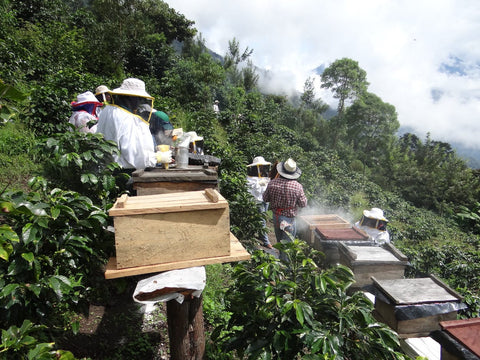First Published - July 9, 2012
One of the most important aspects of coffee cultivation, in addition to being vigilant about disease, is ensuring correct inputs for nutrition takes place. Pascale saw some of the different methods in use on the farms in Guatemala when she looked at coffee planting.
How coffee gets good nutrition?
Coffee trees need to receive essential nutrients. In Guatemala producers usually clear the area surrounding the coffee plant first, and then throw three neat handfuls of compost fertilizer and NPK (Nitrogen, Phosphorous & Potassium) around the base. Coffee plants are fertilized up to three times a year. The frequency mainly depends on the cash that producers have available to buy the products. Fertilizing is one of the most expensive activities for these producers.
In La Libertad and Todos Santos in Guatemala, coffee is grown in shade of other crops. The leaves that fall off the canopy trees also serve as an organic material to enrich the soil. Organic material is important because of the nutrients and mineral material that it returns to the earth.
If you understand Spanish then you can probably guess what is inside this structure, hidden away under a canopy from the sign on the top.
It is full of worms! Some producers in Todos Santos produce their own organic fertilizer. It is a cheap and convenient way of producing organic material. The biggest risk is not covering the infrastructure and giving the birds a nice dinner!
One of the frequently used components of this compost fertilizer is discarded cherry skins, which are removed during post-harvest processing of the beans.
Coffee plants, if properly tended, can continue to produce viable coffee cherries for up to thirty years. However, given that they can also take between three and four seasons to start producing fruits, it’s a case of investing now for reward later when starting out. An outbreak of disease can be devastating for producers, especially if the more mature trees which produce the bulk of the crop, are affected.
Commonly found diseases in coffee
Pascale found out more about some of the most common diseases that can affect coffee in Guatemala when she visited farms with ANACAFE.
Ojo De Gallo
Coffee is susceptible to disease such as Ojo de Gallo or Rooster’s Eye. In Huica, where we visited some parcels which are old in coffee terms (30-40 years) and therefore even more susceptible. We found many cases of Ojo de Gallo. This is a fungus, Mycena citricolor, that can severely harm the plant, but develops slowly. First, the leaves develop a marking pattern called “rooster eyes”, then the leaves will fall off and beans will be affected too and finally the cherries will rot on the tree. Severe crop loss may occur and less coffee means less income.
Ojo de Gallo can be prevented by proper management, since too much moisture & humidity promotes the development of the fungus. High rainfall and too high shade density preventing good air circulation are all contributing factors. Good fertilization and composting to ensure healthy plants also helps with prevention. If coffee parcels are old, the plants can also be removed or pruned to prevent further spread of the disease. Chemical anti fingus applications also can eliminate Ojo de Gallo, but prevention is preferred.
Mancha del Sol
Cultivating coffee is not easy. Although Ojo de Gallo is prevented by providing enough shade, too little can result in Mancha del Sol. They are also easily confused, although Mancha del Sol is characterized by the yellow circle around the black spot. Fortunately, producers in Guatemala do not have to combat diseases such as Roya de café (Hemileia Vastrix) which is one of the biggest problems in cultivating coffee in countries like Colombia – an outbreak can destroy up to 70% of a parcel.
We visited a group of producers in San Miguel Ixcahuacan and went with them to another co-operative at La Libertad. They visited parcels and then also worked with the cuppers from Esquipulas. These type of interactions are important, as producers are more likely to adapt cultivation practices recommended by visiting agronomists when they can see with their own eyes that these practices improve the conditions of the parcels. If you hear you will forget, if you see you will remember…
Producers share knowledge with the help of organisations such as ANACAFE and we at Union also run seminars and workshops for them. We believe it’s really important and we’ll be discussing the role of the co-operative in more detail next time!








